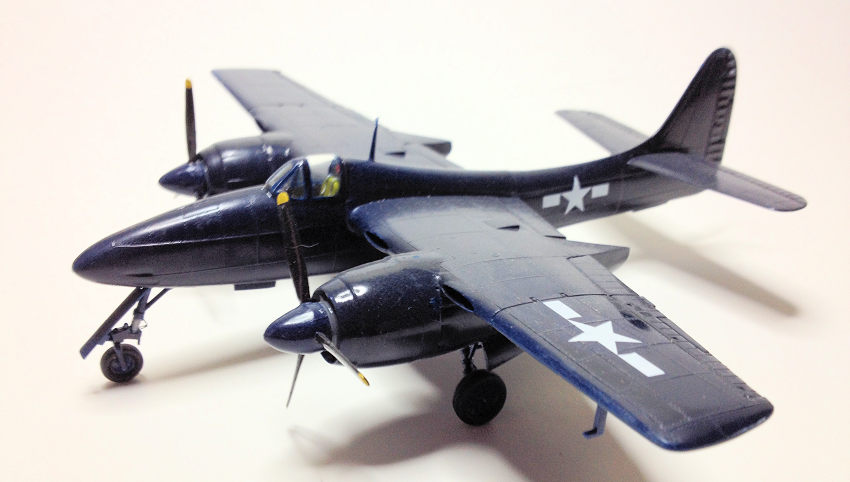
| KIT #: | ? |
| PRICE: | $10.00 when new |
| DECALS: | One option |
| REVIEWER: | Joel Hamm |
| NOTES: |

| HISTORY |
At any airshow or warbird display, one of the stars is sure to be the Grumman Tigercat. Itís big. Itís brawny. Itís beautiful. Itís loud, fast, and powerful. Itís everything wanted in a WWII fighter Ė except it never fought. Delivered too late to serve in its intended role as a Navy / Marine fighter and close support attacker, it found a limited role in Korea, before being eclipsed by the jet age.
| THE KIT |
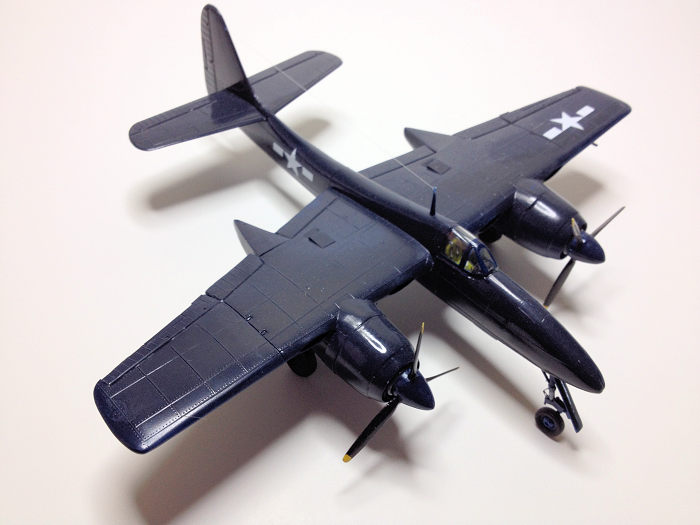 Just about everyone has
built the 1960ís Monogram Tigercat, the only other 1/72 show on the road, which
is still on the road. Itís decently molded, a bit simplistic and toy-like, and
available in any color, as long as itís that Gawdawful neon cobalt blue. Aoshima
is not known for museum quality replicas, but every now and then they come up
with a surprise Ė or at least a starting point. This kit is neither, though it
does assemble into an acceptable specimen. With a few notable glitches, it runs
neck and neck with the Monogram. I wonít (canít) comment on dimensional
accuracy, but it looks OK. Molding is flash-free and crisp. Raised but petite
lines and rivets. Beaucoup hatches, vents, and access panels. Clear clear parts.
Wings can be folded
Just about everyone has
built the 1960ís Monogram Tigercat, the only other 1/72 show on the road, which
is still on the road. Itís decently molded, a bit simplistic and toy-like, and
available in any color, as long as itís that Gawdawful neon cobalt blue. Aoshima
is not known for museum quality replicas, but every now and then they come up
with a surprise Ė or at least a starting point. This kit is neither, though it
does assemble into an acceptable specimen. With a few notable glitches, it runs
neck and neck with the Monogram. I wonít (canít) comment on dimensional
accuracy, but it looks OK. Molding is flash-free and crisp. Raised but petite
lines and rivets. Beaucoup hatches, vents, and access panels. Clear clear parts.
Wings can be folded
| CONSTRUCTION |
In a previous kit review I mentioned building several
throw-away planes for the sake of revitalizing modeling skills. The first was an
early cottage industry short-run (Meikraft P-35) that required
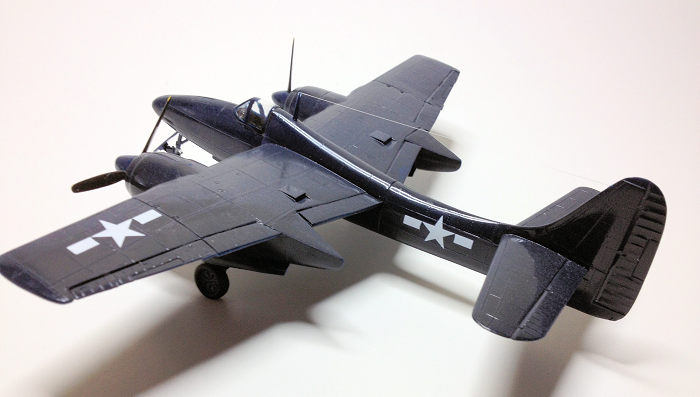 extensive plastic
surgery. This project was supposed to be a quickie toss-together OOB (out of the
box) afternoon affair, but still ended up requiring extensive plastic surgery Ė
well, semi-extensive. Parts go together easily, without filling and filing
Ė EXCEPT!!!!!!! Ė
extensive plastic
surgery. This project was supposed to be a quickie toss-together OOB (out of the
box) afternoon affair, but still ended up requiring extensive plastic surgery Ė
well, semi-extensive. Parts go together easily, without filling and filing
Ė EXCEPT!!!!!!! Ė
There is a serious misalignment of the fuselage just ahead of the cockpit bulkhead. The nose section appears to be shifted to port about a half millimeter. This isnít an assembly error, as the fuselage sides are single pieces nose to tail. It looks like the mold was made in sections and improperly assembled. This is an easy fix with minimal filler and sandpaper if caught before assembly. I missed it until he project was near complete and had to do some fancy footwork with dental burrs and paint touchup. The trick is to avoid altering the canopy mounting surfaces.
Judging by the few available photos of spinner-equipped cats, these parts appear too fat and pointed. They can be lathed down just so far, because the prop blades are integral with the spinner, and the engine crankcase is represented as a wide, flat disc. Optimal fix is to excise the molded-in engine faces from the cowls, and replace them with a set of aftermarket radials and props; but this kit is worth neither the expense nor effort.
T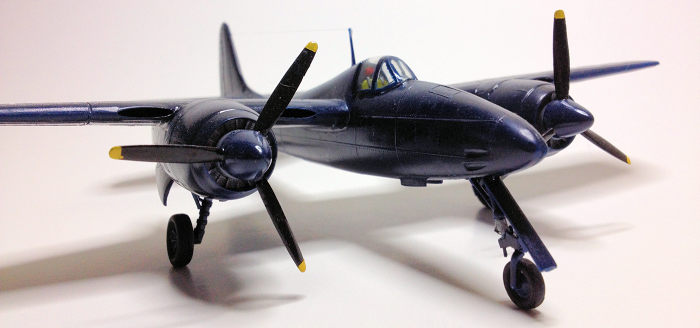 he inboard undersides of the wing panels sport
integral pylons for the 1000lb bombs. Except for one shot from the Pensacola
Museum showing a pair of these weapons sitting on loading carts, no photo could
be found of a Tigercat carrying this ordnance. In any event, these hanging
points are grossly oversize and best ectomied.
he inboard undersides of the wing panels sport
integral pylons for the 1000lb bombs. Except for one shot from the Pensacola
Museum showing a pair of these weapons sitting on loading carts, no photo could
be found of a Tigercat carrying this ordnance. In any event, these hanging
points are grossly oversize and best ectomied.
The canopy is commendably clear and thin, but the space within is void. This is the one area where minimal enhancements can stand out. I sratchbuilt a seat, and added PEB belts from the parts bin, seat color was a question mark, but I found one photo suggesting interior green with a red headrest. I also added an etched instrument panel with photo-film dials, but this is hardly visible. Likewise a control stick from stretched sprue.
The nose needs lots of weight to prevent tail sitting; and the wing leading edge inlets could use some blocking off to suggest radiators or something-or-other inside Ė if anyone will get close enough to inspect.
| COLORS & MARKINGS |
This was a toughie. Decals Ė poor quality ones Ė
are provided for the box art plane, but the colors on that art are questionable.
Are those spinners supposed to be red? Or brown? Is that section behind the
cockpit 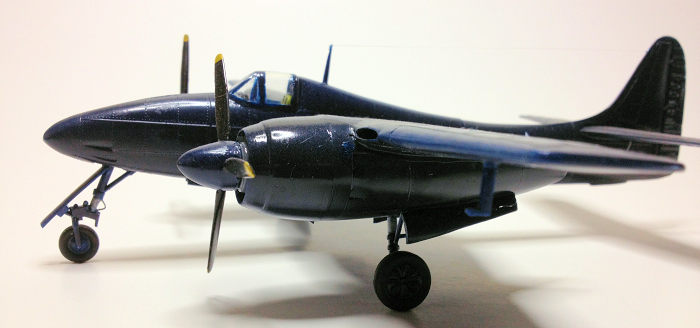 bronze? A yellow tail? If painting directions were included in the
instructions, they werenít helpful Ė I donít read Japanese. Except for some
photos of a spinner-ed, silver USAF derelict, all Tigercats dressed for their
portraits in glossy blue-black. No useable marking schemes could be found, so I
simply hosed the thing in a mix of Testors dark blue and black and laid on
appropriate national insignia from the decal bin. The color of landing gear
legs, hubs, and wells was another question. Some pics showed blue, some, silver,
some white. Since the airbrush was already filled with navy blue, the choice was
simple.
bronze? A yellow tail? If painting directions were included in the
instructions, they werenít helpful Ė I donít read Japanese. Except for some
photos of a spinner-ed, silver USAF derelict, all Tigercats dressed for their
portraits in glossy blue-black. No useable marking schemes could be found, so I
simply hosed the thing in a mix of Testors dark blue and black and laid on
appropriate national insignia from the decal bin. The color of landing gear
legs, hubs, and wells was another question. Some pics showed blue, some, silver,
some white. Since the airbrush was already filled with navy blue, the choice was
simple.
Stick on the landing gear, props, an oversize pitot, and antenna mast. I hadnít seen any F7ís with wire antenna, but it added a touch of authenticity Ė even if it wasnít authentic. One parting bit of enhancement was to cut away the solid triangle representing a torque link on the nose gear and replace it with a PEB part.
| CONCLUSIONS |
What this world needs is a decent 1/72 Grumman Tigercat kit.
20 March 2017
Copyright ModelingMadness.com
If you would like your product reviewed fairly and fairly quickly, please
contact the editor or see other details in the
Note to
Contributors.
Back to the Main Page
Back to the Review Index Page
Back to the Previews Index Page